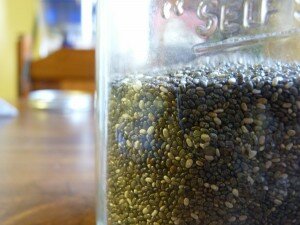Are Chia Seeds Good For You?
I’ll admit that I quickly became excited about chia seeds when they first entered my world. I did a bit of research after reading about them in Born To Run, and got excited about this newly discovered supposedly excellent source of Omega-3 fatty acids.
I ordered a big bag off Amazon.com and started incorporating some into smoothies and otherwise eating them by the spoonful. Recommending them to family and friends, I was a major chia fan to say the very least.
If you’ve never heard of chia seeds, here is a quick rundown:
- They were a major food source of the Mayan and Aztec civilizations
- They ARE the same seeds that grow chia pets (just don’t eat these ones, they’re processed differently)
- They are very high in Omega 3 fatty acids (even higher than flax seeds)
- They are becoming BIG TIME popular with a mention on Oprah by Dr. Oz
- Hold approx. 12 times their weight in water, and thereby aid in hydration
- High in antioxidants
A one ounce serving contains approximately:
- Omega-3 fatty acids: 5g
- Omega-6 fatty acids: 1.6g
- Fiber: 11g (primarily soluble) – total carbs 12g
- Protein: 4g
- Calories: 137
- Calcium: 180 mg
Pretty good stats right?
These stats are great for such an inexpensive food, but they don’t form the complete picture. Much like flaxseeds, the Omega-3 fatty acids contained in chia seeds are in alpha-linolenic acid (ALA) form. Herein lies the problem. The main benefits of Omega-3 ALA consumption is to try and get our bodies to convert it into EPA/DHA fatty acids (the kind found in fish oil), but in most cases our bodies just don’t seem to be efficient at making the conversion (sources: 1,2,3). ALA bio-conversion to EPA is very limited and conversion to the even more important DHA is practically absent. I said “in most cases” because there has been some evidence of the conversion rate being higher in vegans and EPA conversion higher in chronically-ill African-Americans (sources: 1,2).
To put all this more simply: most of the Omega-3’s we get from chia seeds get wasted.
Getting enough of the right (EPA/DHA) Omega-3 fatty acids is extremely important for overall good health – one of the most important dietary things you can do in my opinion. In order to reduce chronic inflammation, we should try to get closer to a 1:1 ratio of Omega-6 to Omega-3 fatty acids. This is vitally important. Most of us get far too much Omega-6 fatty acids, with the typical American’s ratio more around 30:1.
What does all this mean for you?
Most people should be supplementing with Omega’s 3’s to get the O6 to O3 ratio closer to 1:1. And as long as your not vegetarian/vegan, you probably should be taking fish-oil instead of relying on chia seeds. Chia seeds (or flax seeds) just can’t give you the proper Omega-3 benefits.
That being said, I’m going to recommend you still eat them, but for different reasons than you’ve previously heard. Chia seeds are mainly a good food option for their high content of soluble fiber and antioxidants as well as their hydrating properties (when prepared as a gel). So yeah…don’t give up on them just yet!
–
Any questions? Leave a comment and I’ll be sure to respond. If you haven’t already – please subscribe so you don’t miss out on more healthy eating tips in the future.














